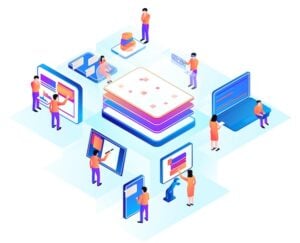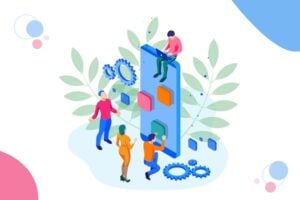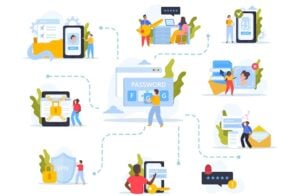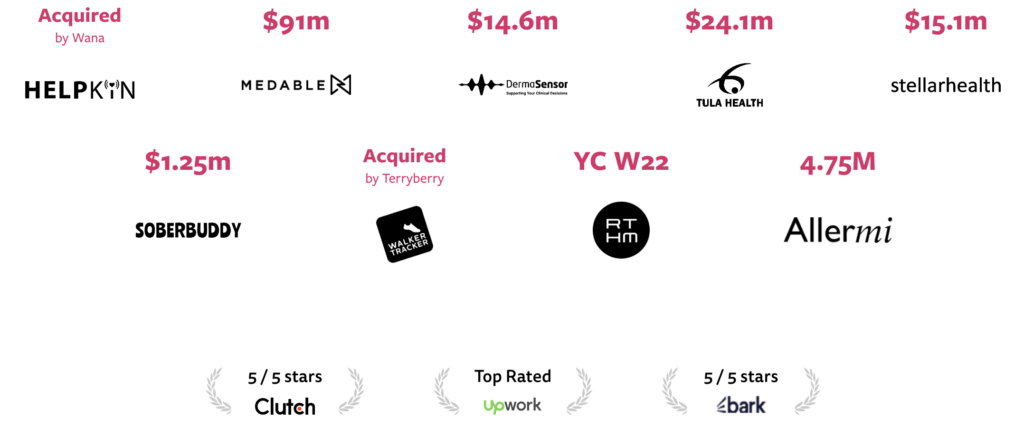If someone had asked me “What is enterprise mobile app development?” 20 years ago when I first entered the IT industry, I would have immediately envisioned tedious board meetings, endless negotiations, and software filled with nothing but gloom and doom. However, the reality of enterprise mobile app development is far from that.
The rise of smartphones and tablets has drastically transformed the way we conduct business. With more and more employees relying on mobile devices for work, it has become essential for businesses to have their own mobile apps to stay competitive.
In this blog post, we’ll dive deep into the world of mobile enterprise application development and uncover cutting-edge strategies and technologies that can drive innovation and efficiency in your organization.
Top Takeaways:
- Ensuring robust security in enterprise mobile apps without compromising user experience is crucial. Techniques like multi-factor authentication, data encryption, and role-based access control help achieve this balance, allowing for secure yet seamless interactions that encourage user adoption and productivity.
- Integrating new mobile applications with legacy systems remains a significant challenge for enterprises. Using APIs, middleware solutions, and custom integration strategies ensures smooth communication and data consistency between modern mobile apps and outdated backend systems, facilitating uninterrupted business operations.
- Effective data management and advanced analytics are vital for maximizing the value of enterprise mobile apps. Implementing centralized data repositories, utilizing advanced analytics tools, enabling real-time reporting, and establishing robust data governance policies support informed decision-making and enhance overall business efficiency.
⚡️ For Our Time-Conscious Readers:
- What are the challenges of enterprise mobile app development?
- How can I scale an enterprise mobility solution faster?
- How can security be ensured in enterprise mobile apps?
- What is the importance of integrating with legacy systems?
- How to ensure greater adoption of enterprise mobility solutions at my business?
Table of Contents:
1. What Is Enterprise Mobile App Development?
2. Challenges of Developing Enterprise Mobile Apps
3. Architecting Your Enterprise Mobile Dream App
4. From Vision to Reality: Building an Enterprise Mobile App Step by Step
- Step 1: Initial Planning and Requirement Gathering
- Step 2: Choosing the Right Development Methodology
- Step 3: Design and Prototyping for User Validation
- Step 4: Development, Testing, and Deployment
- Step 5: Ongoing Maintenance and Support
5. The ROI Equation: The Cost of Enterprise App Development
6. How to Make an Enterprise Mobile Application Secure
7. Your Trusted Partner in Enterprise Mobility: The Topflight Advantage
What Is Enterprise Mobile App Development?
At its core, enterprise mobility refers to the process of designing, creating, and deploying mobile applications that cater specifically to the needs of an enterprise. These applications streamline operations, enhance productivity, and provide real-time data access, ensuring that businesses stay agile and competitive.
The 2024 State of Enterprise Mobility Survey by B2M reveals that every (10 out 10) IT decision-maker surveyed believes that dependable mobile devices and applications are essential for enhancing productivity, optimizing workflows, and ensuring business success.
Current Trends of Enterprise Mobile Application Development
Enterprise mobility isn’t just a trend; it’s an evolutionary step in how businesses operate. As we move away from bulky legacy systems, mobile apps are becoming the backbone of modern enterprises. Consider these prevailing trends in enterprise-level mobile software:
- Remote Work Enablement: With a significant shift towards remote work, enterprise apps are critical in maintaining seamless communication and collaboration.
- AI and Machine Learning Integration: Businesses are leveraging AI to predict outcomes, automate processes, and deliver personalized experiences through their mobile platforms.
- Generative AI: Enterprises are using generative AI to create content, automate workflows, and enhance user experiences, driving efficiency and innovation.
- BYOD (Bring Your Own Device): Allowing employees to use personal devices for work increases flexibility and satisfaction while reducing hardware costs, but requires robust security measures.
One effective way to manage and secure BYOD environments is through Enterprise Mobility Management (EMM) or Mobile Device Management (MDM) solutions. These tools allow IT administrators to control and monitor the software installed on employees’ devices, ensuring compliance with corporate policies and maintaining security standards. Key features of EMM/MDM solutions:
- Enterprise Profiling: IT administrators can create and manage user profiles, specifying which apps and data are accessible based on roles within the organization.
- Remote App Management: Admins can remotely install, update, or remove enterprise applications across all company-approved mobile devices, ensuring that all users have the latest and most secure versions.
- Security Enforcement: Implementing security protocols such as encryption, remote wiping, and device lockdown capabilities to protect corporate data even if a device is lost or stolen.
- Compliance Monitoring: Continuous monitoring of devices to ensure they comply with company policies and industry regulations, mitigating risks related to data breaches and unauthorized access.
- Big Data: Mobile apps are collecting and analyzing vast amounts of data, providing valuable insights and enhancing decision-making capabilities.
- Cloud Computing: By leveraging the power of the cloud, enterprise mobile apps can increase efficiency, reduce costs, and facilitate remote data access.
- Enhanced Security Protocols: Given the sensitivity of enterprise data, there’s a strong focus on developing robust security frameworks within mobile apps.
Food for thought: Are your current systems equipped to adapt to these evolving trends, or is it time for an overhaul?
The Compelling Benefits of Enterprise Mobile App Development
Enterprise mobile solutions offer a multitude of benefits beyond mere convenience. Here’s why investing in mobile app development is a strategic move:
- Increased Efficiency: Mobile apps streamline workflows by automating routine tasks and providing instant access to essential data.
Disney engineers developed a hybrid mobile app to save their guest transportation service, Disney’s Magical Express (running at the time on no longer supported legacy devices). This application ensured a consistent and high-quality user experience across multiple devices, thus enhancing customer satisfaction and operational efficiency.
- Improved Decision-Making: Real-time analytics and reporting empower decision-makers with actionable insights.
Duke Energy’s “Field Service Edge” app replaced outdated paper systems with real-time data access for technicians, slashing repair times by 40% and boosting customer satisfaction.
- Enhanced Customer Engagement: Mobile apps offer personalized services, driving customer satisfaction and loyalty.
The American Automobile Association (AAA) switched to a cross-platform solution to upgrade their mobile application, providing superior service to over 62 million customers. This collaboration significantly boosted customer engagement through elevated user experience and real-time Updates.
- Cost Reduction: Automating processes and reducing manual intervention lowers operational costs considerably.
Coca-Cola bottlers implemented Spring Global’s mobile solution for their field sales teams, significantly enhancing operational efficiency. This application reduced field equipment costs by 80%, increased order accuracy by 30%, and saved reps an average of 90 minutes per day. The solution was deployed in just 3 months, rapidly improving productivity and driving revenue growth through more strategic selling time.
Food for thought: Have you ever calculated how much your organization could save annually by streamlining operations through a custom mobile app?
Also Read: Custom Mobile App Development: A Complete Guide
Types of Enterprise Software Applications
Understanding the different types of enterprise apps is crucial for aligning them with your business needs. Here are the primary categories:
- Employee Productivity Apps: Tools designed to boost employee efficiency, such as project collaboration and management apps.
- Customer Relationship Management (CRM) Applications: Apps that help manage customer interactions and data, enhancing customer service and retention.
- Field Service Management Software: Mobile solutions for managing field operations, ensuring that remote teams remain connected and productive.
- Enterprise Resource Planning (ERP) Apps: Comprehensive apps that integrate various business processes, from procurement to HR management.
Food for thought: Which type of enterprise mobile application would most dramatically transform your business operations?
Enterprise mobility is no longer optional—it’s imperative for businesses aiming to thrive in today’s competitive landscape. As we’ve outlined, understanding what enterprise mobile app development entails, recognizing current trends, and identifying the various types of applications are foundational steps.
Next, we’ll dive deeper into the challenges enterprises face and how to overcome them, ensuring your mobile strategy is both effective and resilient.
Challenges of Developing Enterprise Mobile Apps
Enterprise mobile application development presents a unique set of challenges that extend well beyond those faced by consumer app developers. For enterprises, understanding these hurdles and how to overcome them is crucial for success. In this section, we’ll delve into the specific difficulties inherent in enterprise mobile development and explore practical solutions.
Beyond Consumer Apps: Unique Challenges in the Enterprise Environment
Developing mobile applications for enterprises involves navigating a complex landscape with distinct requirements and constraints. Here are some of the primary challenges:
- Complex Workflows: Enterprise apps must support intricate workflows that span multiple departments and functions.
- Security Concerns: Protecting sensitive business data and intellectual property necessitates robust security frameworks.
- Scalability: As businesses grow, their mobile applications need to scale seamlessly to handle increased user loads and data volume.
- Integration with Legacy Systems: Many enterprises rely on legacy systems that must be integrated with new mobile solutions without disrupting current operations (often running on old operating systems).
Food for Thought: Are your current mobile apps able to handle your company’s complex workflows and integrate smoothly with your existing systems?
Fortress or Friendliness? Balancing Security and a Frictionless User Experience
Security is a top priority in enterprise mobile applications development. However, it’s essential to balance stringent security measures with a frictionless user experience to ensure adoption and productivity. Here’s how you can achieve this balance:
- Multi-Factor Authentication (MFA): Enhance security without compromising user convenience by adding an extra authentication layer.
- Data Encryption: Encrypt data at rest and in transit to protect against unauthorized access and breaches.
- Role-Based Access Control: Implement user access control based on roles to ensure that employees only have access to the information they need.
- Regular Security Audits: Conduct frequent security audits to identify and address potential vulnerabilities proactively.
At the same time, your employees are used to smooth user experiences on their own devices, and they expect nothing less from their work tools.
For example, even though employees might prefer using their favorite portfolio tracking apps to manage clients’ money, in an enterprise setting, they must adhere to using company-approved apps for security and compliance reasons. Thus, enterprise apps need to strike a balance between security/compliance and user experience to be effective.
This means that an intuitive user interface and engaging app mechanics should remain top priorities when building enterprise mobile applications.
Food for Thought: How does your current mobile security strategy impact user experience? Are there opportunities to enhance security without adding unnecessary friction?
Bridging the Gap: Integrating Seamlessly with Legacy Systems
One of the greatest challenges in enterprise mobile software development is ensuring seamless integration with legacy systems. Here are some strategies to bridge this gap effectively:
- APIs and Middleware: Utilize APIs and middleware to facilitate communication between new mobile applications and legacy systems.
- Data Synchronization: Ensure real-time data synchronization between mobile apps and backend systems to maintain consistency.
- Custom Integration Solutions: Develop custom integration solutions, such as data hubs, tailored to your specific needs and system architecture to ensure smooth interoperability.
Of course, it’s unrealistic to expect that all enterprise software can get updates at the same time. Therefore, an enterprise mobility solution is likely to sync data with a number of existing systems.
Food for Thought: Are your legacy systems ready to integrate with modern mobile applications, or do you need to invest in custom integration solutions?
Data Powerhouse: Optimizing Data Management and Analytics for Enterprise Mobility
Effective data management and analytics are critical for maximizing the value of your enterprise mobile apps. Here’s how you can optimize data handling and leverage analytics:
- Centralized Data Repositories: Implement centralized data repositories to streamline data access and management.
- Advanced Analytics Tools: Utilize advanced analytics tools to extract actionable insights from your mobile app data.
- Real-Time Reporting: Enable real-time reporting and dashboards to support informed decision-making.
- Data Governance Policies: Establish robust data governance policies to ensure data accuracy, security, and compliance.
Food for Thought: How effectively are you managing and analyzing the data generated by your mobile applications? Are there opportunities to leverage advanced analytics for better decision-making?
Navigating the complexities of enterprise mobile application development requires a strategic approach and technical expertise. By addressing the unique challenges of the enterprise environment, balancing security with user experience, integrating with legacy systems, and optimizing data management, you can unlock the full potential of your mobile solutions.
Ready to tackle these challenges head-on? Stay tuned for the next section, where we’ll delve into the essential features and architecture of a successful enterprise mobile app.
Architecting Your Enterprise Mobile Dream App
Creating a robust and scalable mobile application for enterprises requires meticulous planning, strategic decision-making, and an understanding of the essential features that drive success.
Let’s explore the must-have features, scalability considerations, and development approaches crucial for mobile app development for enterprise. By leveraging best practices and real-world insights, you’ll be better equipped to build an app that not only meets but exceeds your business goals.
Must-Have Features for of Enterprise Mobile Apps
When designing a mobile app for enterprise, certain features are non-negotiable. These features ensure that the app is functional, secure, and user-friendly, while also delivering significant business value.
Seamless Integration Capabilities
Enterprise apps must integrate with existing systems and platforms seamlessly. This includes:
- APIs: Utilizing APIs to connect the mobile app with backend systems, such as CRMs, ERPs, and other enterprise software.
- Middleware Solutions: Implementing middleware solutions to facilitate smooth data exchange between different systems.
Offline Functionality
Ensuring that the app can function offline is critical, especially for field employees who may not always have reliable internet access. Key components include:
- Data Caching: Caching data locally so users can continue working even without a network connection.
- Automatic Sync: Automatically syncing data when the device reconnects to the internet.
Advanced Analytics and Reporting
To drive informed decision-making, your app should offer advanced analytics and reporting capabilities. This involves:
- Real-Time Analytics: Providing real-time data insights to track performance and usage patterns.
- Customizable Dashboards: Allowing users to create custom dashboards to visualize key metrics relevant to their roles.
User Management and Access Control
Managing users and controlling their access within the app is essential for maintaining security and efficiency. Features include:
- Role-Based Access Control: Assigning permissions based on user roles to restrict access to sensitive information.
- User Activity Monitoring: Tracking user activities within the app to ensure compliance and security.
Push Notifications and Alerts
Keep your team informed and engaged with targeted, context-aware notifications that drive action and improve responsiveness:
- Targeted Notifications: Sending notifications tailored to specific user roles or departments.
- Context-Aware Alerts: Providing alerts based on the user’s current context or activity.
Collaborative Features
Foster teamwork and knowledge sharing with built-in communication tools, document sharing, and project management capabilities:
- Communication Tools: Integrating chat, video calls, and messaging functionalities.
- Document Sharing: Allowing users to share and collaborate on documents within the app.
- Project Management: Including tools for task assignment, progress tracking, and deadline management.
Food for Thought: Does your current mobile strategy include these must-have features? Are there gaps where your app could deliver more value?
Non-Essential Features That Can Be Ignored
While building an enterprise mobile app, it’s crucial to focus on features that directly impact the bottom line. Here are some non-essential features that might not be a priority:
- Social Media Integration: While useful for consumer apps, integrating social media features isn’t critical for enterprise applications.
- In-App Purchases: Enterprise apps typically don’t rely on in-app purchases as a revenue model.
- Games and Entertainment: Gamification can be beneficial, but full-fledged games and entertainment features are generally unnecessary.
- Custom Themes and Skins: Customizing the look and feel of the app with themes or skins may not provide enough ROI to justify the development effort.
- Extensive animation and visual effects: While aesthetically pleasing, they can distract from core business functions.
- Location-based services: Unless central to your business operations, GPS features may not be essential. [Exception: field service apps]
- Advanced features: AR/VR, voice-activated controls, etc.
By focusing on essential features and deprioritizing non-essential ones, you can ensure that your enterprise mobile app delivers maximum value without unnecessary complexity.
Built to Scale: Ensuring Performance and Scalability for Future Growth
Scalability is a cornerstone of successful mobile app development for enterprise. As your business grows, your app must be able to handle increased user loads and data volumes without compromising performance.
Performance Optimization
Optimizing performance from the outset ensures that your app remains responsive and efficient. Key strategies include:
- Load Testing: Conducting load testing to identify and address performance bottlenecks.
- Efficient Coding Practices: Adopting efficient coding practices to minimize resource consumption.
Scalable Architecture
Designing a scalable architecture allows your app to grow with your business. Considerations include:
- Modular Design: Using a modular design approach to easily add or update features without disrupting existing functionality.
- Cloud-Based Solutions: Leveraging cloud services to scale resources dynamically based on demand.
Food for Thought: Is your current app architecture designed to scale seamlessly as your business grows? Are you prepared to handle increased user loads and data volumes?
Native Strength or Cross-Platform Reach? Choosing the Right Development Approach
Choosing the right development approach is a critical decision in mobile app development for enterprise. Depending on your business needs and resources, you can opt for native development, cross-platform development, or even a mobile web app.
Native Development
Building native apps involves developing separate apps for each operating system (iOS and Android). Benefits include:
- Performance: Native apps typically offer superior performance and responsiveness.
- Access to Device Features: Full access to device-specific features and hardware capabilities.
Cross-Platform Development
Cross-platform development allows you to build a single app that works across multiple platforms. Advantages include:
- Cost-Effectiveness: Reduces development costs by reusing code across platforms.
- Faster Time-to-Market: Accelerates the development process by eliminating the need for separate codebases.
Web App
A mobile web app runs in any mobile browser on any smartphone, making it a cost-effective solution for less resource-intensive applications. Benefits include:
- Accessibility: Can be accessed from any device with a web browser.
- Maintenance: Easier to maintain and update compared to native apps.
Food for Thought: Which development platform aligns best with your business goals and resources? Are you prioritizing performance, cost-efficiency, time to market, or accessibility?
Real-World Success Story: Walker Tracker
Let’s look at our long-term partnership with Walker Tracker, a digital wellness platform. Originally suffering from poor ratings and user reviews, Walker Tracker partnered with Topflight to revamp their mobile app. Using cross-platform technologies like React Native, we improved the app’s rating from 2.3 to 4.6 stars and significantly boosted user engagement.
We implemented features such as seamless integration with health tracking systems, advanced analytics, and push notifications, which led to an increase in user satisfaction and engagement. Our major wins with Walker Tracker include:
- prestigious awards like the Web Excellence Awards and Gold Stevie Winner.
- acquisition by Terryberry, a leading provider of employee recognition and engagement solutions.
While we haven’t yet worked on a mobile enterprise app requiring native development tools, we believe such scenarios would involve complex tasks like running on-device machine learning algorithms or using specialized hardware like iPhone’s LiDAR sensors. However, our Walker Tracker experience demonstrates that cross-platform technologies can effectively meet enterprise needs, providing cost-efficiency and faster time-to-market.
Food for Thought: Which development approach aligns best with your business goals and resources? Are you prioritizing performance, cost-efficiency, or accessibility?
As you understand, building a successful enterprise mobile app requires careful consideration of essential features, scalability, and the right development approach. By focusing on seamless integration, offline functionality, advanced analytics, user management, and scalable architecture, you can ensure your app delivers significant business value. Additionally, choosing between native, cross-platform, or web app development based on your specific needs will set the foundation for long-term success.
Ready to turn your enterprise mobile app vision into reality? Stay tuned for the next section, where we’ll guide you through the initial planning and requirement gathering phase of the development journey.
From Vision to Reality: Building an Enterprise Mobile App Step by Step
Embarking on the enterprise mobile app development process can be a complex and demanding endeavor. However, with a clear roadmap and a strategic approach, you can transform your vision into a successful mobile application that drives business value.
In this part, we’ll guide you through each phase of the enterprise app development process, offering practical advice and real-world insights from our experience at Topflight. All in all, there are 5 principal phases in this development process:
- Step #1: Initial Planning and Requirement Gathering
- Step #2: Choosing the Right Development Methodology
- Step #3: Design and Prototyping for User Validation
- Step #4: Development, Testing, and Deployment
- Step #5: Ongoing Maintenance and Support
Now let’s take a closer look at each phase, one by one.
Step #1: Initial Planning and Requirement Gathering
The foundation of any successful enterprise mobile app begins with thorough planning and requirement gathering. This stage involves understanding the business needs and translating them into actionable requirements.
Key Steps:
- Stakeholder Interviews: Engage with key stakeholders to gather insights and understand their expectations.
- Define Business Objectives: Clearly outline the business objectives the app aims to achieve, the KPIs for tracking this, and ROI expectations.
- User Personas: Identify the primary users and create detailed personas to guide design and functionality decisions.
- Feature Prioritization: List all potential features and prioritize them based on business impact and feasibility.
Food for Thought: Have you involved all relevant stakeholders in the planning phase to ensure that the app aligns with business goals and user needs?
Step #2: Choosing the Right Development Methodology
Selecting the appropriate development methodology is critical to the project’s success. At Topflight, we advocate for Agile methodologies due to their flexibility and iterative nature.
Benefits of Agile:
- Iterative Development: Agile allows for continuous improvement through iterative cycles, ensuring that the app evolves based on user feedback.
- Flexibility: The Agile approach accommodates changes in requirements and priorities, making it suitable for dynamic business environments.
- Collaboration: Agile promotes close collaboration between developers, stakeholders, and users, fostering better communication and alignment.
Food for Thought: Is your current development process adaptable to changing requirements and user feedback? Can it support ongoing collaboration between teams?
Speed up your project with our proven strategies for fintech app development, enabling you to launch market-ready apps in record time.
Step #3: Design and Prototyping for User Validation
Design and prototyping are crucial stages in the enterprise mobile app design and development process. This phase focuses on translating requirements into visual and interactive prototypes to validate with users.
Key Activities:
- Wireframing: Create wireframes to outline the app’s structure and layout.
- UI/UX Design: Develop high-fidelity designs to define the look and feel of the app.
- Interactive Prototypes: Build interactive prototypes to demonstrate how the app will function.
- User Testing: Conduct user testing sessions to gather feedback and refine the design.
While you may think user engagement isn’t as crucial for enterprise mobility app development as it is for ecommerce app development, validating your assumption is key to ensuring your app aligns with user needs.
Real-World Success Story
In our work with Walker Tracker, an employee wellness platform, we emphasized extensive user testing during the prototyping phase. This approach helped us identify usability issues early and make necessary adjustments, ultimately resulting in a user-friendly app that received positive feedback from its users.
- improved the app’s rating from 2.3 to 4.6
- 1.7x more user reviews
- gained 18.8K ratings in the App Store
Food for Thought: Are you incorporating user feedback early in the design process to ensure the app meets user expectations and business goals?
Step #4: Development, Testing, and Deployment
The development phase brings your app’s design to life. It’s essential to follow best practices and leverage modern development tools to ensure a robust and scalable application.
Development Best Practices:
- Modular Architecture: Use a modular architecture to facilitate maintenance and scalability.
- Cloud-Based Solutions: Leverage cloud-based services for data storage, processing, and scalability.
- Third-Party Integrations: Integrate third-party services and APIs to enhance functionality and reduce development time.
- Low code/no code: Use the corresponding application platforms when you need to release a rapid proof of concept and validate it with stakeholders.
Related: Low code/no code vs Traditional app development guide
Testing:
- Automated Testing: Implement automated testing to quickly identify and fix issues.
- Manual Testing: Conduct comprehensive manual testing to ensure the app functions as expected in real-world scenarios.
- Performance Testing: Test the app’s performance under various conditions to ensure it can handle peak loads.
Deployment:
- Staging Environment: Use a staging environment to deploy the app for final testing before production release.
- Continuous Deployment: Adopt continuous deployment practices to streamline updates and enhancements.
Food for Thought: Are you leveraging cloud-based solutions and third-party integrations to enhance your app’s functionality and scalability? Is your testing strategy comprehensive enough to ensure a smooth deployment?
Naturally, partnering with a seasoned expert in your field is crucial. For instance, opt for a reputable fintech app development company when developing financial enterprise software.
Step #5: Ongoing Maintenance and Support
Launching the app is just the beginning. Continuous maintenance and support are vital to keeping the app functional, secure, and up-to-date.
Maintenance Activities:
- Regular Updates: Release regular updates to add new features, fix bugs, and improve performance.
- Security Patches: Apply security patches promptly to protect against vulnerabilities.
- User Support: Provide ongoing support to address user issues and gather feedback for future improvements.
Real-World Success Story
Our long-term partnership with Walker Tracker, an employee wellness platform, highlights the importance of continuous support and maintenance. Over a span of more than five years, we collaborated closely with their team to revamp their mobile application and ensure its sustained success.
Our collaboration continued even after Walker Tracker’s acquisition by Terryberry in 2022. This extended partnership underscores the necessity of ongoing work post-launch to keep the app competitive and aligned with evolving user needs.
Food for Thought: Do you have a robust maintenance plan in place to ensure the app remains secure, up-to-date, and aligned with user needs?
Transforming an idea into a reality through the enterprise mobile app development process requires careful planning, an agile mindset, and a commitment to ongoing improvement. By following a structured approach and leveraging best practices, you can create a mobile application that delivers substantial business value and meets user expectations.
Ready to embark on the journey of enterprise mobile app design and development? Stay tuned for the next section, where we’ll delve into measuring the ROI of your enterprise mobile app.
The ROI Equation: The Cost of Enterprise App Development
We know that numbers and tables are your go-to tools when estimating the efficiency and success of your projects. For decision-makers like you, it’s crucial to ensure that every investment leads to tangible benefits like increased productivity, streamlined workflows, and innovation.
Let’s dive into how you can quantify success, understand the total cost of ownership, and share inspiring case studies that showcase the real-world impact of enterprise mobile apps development.
Quantifying Success: Increased Productivity, Efficiency, and Innovation
An effective enterprise mobile application can significantly boost productivity, streamline workflows, and foster innovation within an organization. But how do you quantify these benefits?
Key Metrics to Consider:
- Productivity Gains: Measure improvements in employee performance and task completion times. For instance, how much faster are tasks completed with the app compared to previous methods? This might include metrics like time saved on tasks, reduction in errors or rework, increase in output/throughput, improved quality of work, customer satisfaction scores,employee engagement and satisfaction, etc.
- Efficiency Improvements: Track reductions in operational costs and resource utilization. How has the app helped streamline processes and reduce waste?
- Innovation Impact: Evaluate new business opportunities and revenue streams generated through the app. Has the app enabled the creation of new products or services?
Always benchmark against industry standards by comparing your organization’s performance metrics against industry benchmarks to contextualize improvements.
Real-World Data:
IT leaders recognize how essential reliable mobile devices and apps are for their frontline workers. A report by B2M highlights that these tools significantly impact several key areas:
- 99% believe they boost frontline worker productivity.
- 97% say they contribute to revenue growth.
- 98% feel they enhance the ability and speed of decision-making.
- 97% note improvements in workflows.
- 98% report better customer service and customer experience.
Food for Thought: Are you currently tracking the right metrics to measure the productivity and efficiency gains from your enterprise mobile app? How do these metrics align with your overall business goals?
Beyond Development Costs: Understanding the Total Cost of Ownership
When evaluating the ROI of mobile enterprise app development, it’s essential to consider the total cost of ownership (TCO) besides the initial app development costs. TCO encompasses not only the initial development costs but also ongoing expenses related to maintenance, upgrades, and support.
Components of TCO:
- Initial Development Costs: This includes the cost of design, development, and testing.
- Maintenance and Support: Ongoing costs to keep the app functional, secure, and up-to-date.
- Upgrades and Enhancements: Costs associated with adding new features and improving existing ones.
- User Training and Onboarding: Expenses for training employees to use the app effectively.
Cost-Benefit Analysis:
To get a comprehensive view of the app’s financial impact, perform a cost-benefit analysis by comparing the TCO against the quantified benefits, such as productivity gains and cost savings.
TCO Example:
A healthcare provider implemented an enterprise mobile app to streamline patient management and reduce paperwork. Despite an initial development cost of $500,000, the app led to annual savings of $200,000 in administrative costs and a 20% increase in patient throughput. Over five years, the app provided a net benefit of $1.5 million, demonstrating a clear positive ROI.
Food for Thought: Have you accounted for all components of TCO in your budget planning? How does your cost-benefit analysis support the investment in enterprise mobile apps development?
The budget required to release an enterprise mobility solution is always unique. However, based on our experience, to develop an MVP (Minimum Viable Product) that achieves ROI-positive status shortly after launch would typically range from $200,000 to $400,000.
Real-World Impact: Inspiring Case Studies of Enterprise Mobile Success
Examining real-world examples can provide valuable insights into the potential impact of enterprise mobile apps. Here, we showcase successful implementations that highlight the transformative power of mobile solutions.
GaleAI: Transforming Medical Coding for Enhanced ROI
A healthcare provider adopted GaleAI, an advanced AI platform developed by Topflight, to automate their medical coding and billing processes. This enterprise software solution quickly proved its value by reducing administrative burdens and optimizing billing accuracy.
Despite initial development costs, GaleAI led to significant financial benefits for the provider:
- Revenue Uplift: Achieved up to 15% higher revenues by eliminating under-coding.
- Time Efficiency: Reduced time spent on coding by 97%.
In a one-month retrospective audit, GaleAI identified up to $1.14 million in lost revenue due to under-coding by human coders, uncovering a 7.9% error rate that had previously gone unnoticed. The cost of implementing GaleAI was less than 1% of the recovered revenue, demonstrating a clear positive ROI.
Measuring the ROI of enterprise mobile apps development is critical for justifying investments and guiding future strategies. By quantifying success through key metrics, understanding the total cost of ownership, and learning from real-world case studies, decision-makers can make informed choices that drive business value.
Ready to see what Topflight Apps can do for your enterprise? Contact us today to schedule a consultation and start transforming your mobile app vision into reality.
How to Make an Enterprise Mobile Application Secure
In today’s digital age, enterprise data is more valuable and vulnerable than ever. As organizations embark on the journey to develop enterprise mobile apps, securing this data becomes paramount. The stakes are high: not only do data breaches expose sensitive information, they also erode trust and can lead to significant financial losses. This section will delve into essential security measures, regulatory considerations, and ongoing best practices to ensure your enterprise mobile app remains a fortress of protection.
Multi-Layered Security Measures
Implementing a multi-layered security approach is crucial in protecting enterprise data. This strategy involves several defensive mechanisms that work together to create a secure environment for your mobile applications.
- Data Encryption and Secure Communication: Encrypt all data at rest and in transit to ensure that even if data is intercepted, it cannot be read without the encryption key.
- Question to Ponder: Are you confident that your current data encryption methods meet the highest security standards?
- Regular Security Audits and Compliance Checks: Conduct regular security audits to identify and rectify vulnerabilities. Compliance checks ensure that your mobile app adheres to industry regulations and standards.
- Question to Ponder: How frequently do you perform security audits on your enterprise mobile applications?
- Managing User Authentication and Authorization: Implement strong user authentication mechanisms such as multi-factor authentication (MFA) and single sign-on (SSO). Control access through role-based permissions to minimize unauthorized access.
- Question to Ponder: Is your current user authentication system robust enough to prevent unauthorized access?
Navigating Regulatory Considerations
Compliance with regulations is not just a legal obligation but also a best practice for maintaining trust and integrity. Various industries have specific regulations that must be met when developing enterprise mobile apps.
- Healthcare Industry: Follow HIPAA guidelines to protect patient information.
- Financial Sector: Adhere to GDPR, PCI DSS, and other regulatory standards to safeguard financial data.
Understanding and implementing these regulations within your mobile app development process is critical. It not only ensures legal compliance but also enhances your organization’s reputation for data protection.
Food for Thought: Are you well-versed in the regulatory requirements applicable to your industry, and how do you ensure compliance during app development?
Learn how to make a banking app that not only meets regulatory standards but also provides an exceptional user experience.
Best Practices for Ongoing Security Management
Security is not a one-time task but an ongoing commitment. Implementing best practices for continuous security management helps in proactively identifying and mitigating potential threats.
- Continuous Monitoring and Threat Detection: Use advanced monitoring tools to detect and respond to security threats in real-time. Regularly update and patch your systems and software to protect against new vulnerabilities.
- Question to Ponder: How effectively are you monitoring your enterprise mobile apps for potential security breaches?
- Employee Training and Awareness Programs: Educate your employees on security best practices and the importance of following them. Human error is often the weakest link in security, so regular training can significantly reduce risks.
- Question to Ponder: How comprehensive is your employee training program on security protocols?
- Incident Response Plan: Develop and maintain a robust incident response plan to quickly address and mitigate the impact of any security breaches. Ensure that your team knows their roles and responsibilities during a security incident.
- Question to Ponder: Is your incident response plan up-to-date and tested regularly to handle potential security breaches?
Legit Concerns: How prepared is your organization to defend against evolving security threats in the mobile landscape? Are you ready to partner with a trusted expert to fortify your enterprise mobile app security?
Our comprehensive guide explains how to build a neobank from scratch, focusing on security, scalability, and user engagement.
Your Trusted Partner in Enterprise Mobility: The Topflight Advantage
At Topflight, we understand the critical nature of enterprise mobility and the transformative impact it can have on your organization. Our dedication to delivering exceptional mobile app solutions is backed by years of experience and a deep understanding of the unique challenges faced by enterprises.
Key Reasons to Choose Topflight:
- Proven Expertise: We have a track record of successfully delivering enterprise-grade mobile applications across various industries, including healthcare and fintech.
- Tailored Solutions: Our team takes the time to understand your specific business needs and crafts custom solutions that drive efficiency and innovation.
- Robust Security: Security is at the forefront of our development process, ensuring your data is protected through multi-layered security measures.
Next Steps: Initiating Your Enterprise Mobile Journey
Embarking on the journey to develop an enterprise mobile app requires a trusted partner who can guide you through each phase. At Topflight, we start by understanding your vision and objectives, followed by meticulous planning and execution.
Steps to Get Started:
- Initial Consultation: Discuss your goals, challenges, and requirements with our expert team.
- Comprehensive Assessment: We conduct a thorough analysis of your current systems and identify opportunities for integration and improvement.
- Customized Proposal: Receive a detailed proposal outlining our approach, timeline, and cost estimates.
Our Expertise and Experience
Our extensive experience in mobile app development sets us apart as a leading development company. We specialize in creating scalable, secure, and user-friendly enterprise mobile apps that deliver measurable results.
Industry Experience:
- Healthcare: Developing apps that streamline patient management, enhance communication, and ensure regulatory compliance.
- Fintech: Creating secure and efficient solutions for financial services, including mobile banking and investment platforms.
Case Studies and Success Stories
Walker Tracker: A Path to Enterprise Mobility Success (check out the case study here)
Walker Tracker, a comprehensive health and wellness platform, partnered with Topflight to enhance their mobile app offering. This collaboration resulted in significant achievements:
- Increased User Engagement: Achieved a 30% increase in active users over three years.
- Streamlined Data Integration: Integrated seamlessly with multiple health tracking devices.
- Enhanced User Experience: Improved app usability and performance, leading to higher user satisfaction.
Our Development Approach and Best Practices
At Topflight, we follow a structured development approach that ensures timely delivery and high-quality outcomes. Our methodology includes:
- Agile Development: Embracing Agile methodologies to adapt to changes and deliver iterative improvements.
- Shared Responsibility: We take ownership of our engagement’s results, focusing on meeting ROI goals and improving key performance indicators (KPIs).
- User-Centric Design: Focusing on designing intuitive and engaging user interfaces.
- Rigorous Testing: Conducting thorough testing to identify and resolve issues before deployment.
- Regular Updates: We ensure your app remains up-to-date with the latest features and security patches.
Ready to take the next step in transforming your enterprise with a cutting-edge mobile app? Schedule a consultation with our experts today to discuss your project and learn how we can help you build enterprise mobile apps that drive business success.
Frequently Asked Questions
What are the trends for enterprise mobile app development?
Current trends include the integration of AI and machine learning, enhanced security measures, IoT connectivity, cloud computing, and the adoption of low-code/no-code platforms. These trends help improve efficiency, scalability, and user experience for enterprise apps.
What is the difference between an enterprise application and a web application?
Enterprise applications are designed to meet the needs of an organization, offering complex functionalities and integrations, while web applications are typically accessible via browsers and serve broader, often less complex purposes.
What are the challenges of mobile enterprise application development?
Challenges include ensuring robust security, integrating with legacy systems, maintaining scalability, providing a seamless user experience, and managing device fragmentation across different operating systems and devices.
What is enterprise mobile app development?
Enterprise mobile app development involves creating mobile applications specifically designed to meet the needs of businesses, focusing on improving efficiency, productivity, and workflows within an organization.
What are the benefits of enterprise mobile app development?
Benefits include increased efficiency, streamlined workflows, improved employee productivity, enhanced data management, better decision-making capabilities through analytics, and higher return on investment (ROI).
What are the main stages of mobile application development?
The main stages include initial planning and requirement gathering, design and prototyping, development, testing, deployment, and ongoing maintenance and support.
How do enterprise mobile apps work?
Enterprise mobile apps work by connecting employees and business processes through mobile devices, enabling real-time access to data, collaboration tools, and business-critical functionalities, thereby optimizing workflows and productivity.






